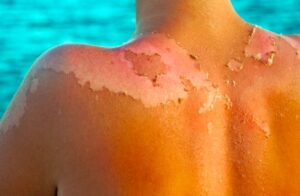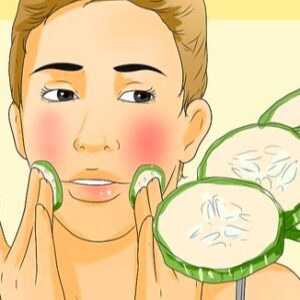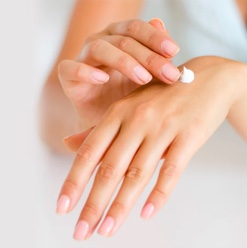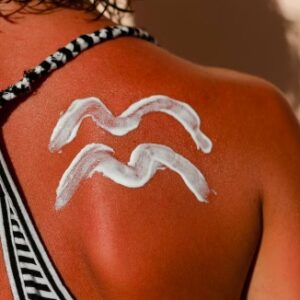Some people have naturally brown skin, while others go for artificial tanning methods to make their skin look brown. According to them, tanning makes them look more attractive and enhances their confidence. They either use tanning products or just opt for natural tanning in the sun.
Relaxing on a beach for tanning sounds very peaceful, right? Sun burns the skin and people hope for this sunburnt skin to turn into a tan. So, does it really happen? How can we turn a sunburn into a tan? Let’s discuss it!
Table of Contents:
- Part 1: Understanding Sunburn and Tanning
- Part 2: Does a Sunburn Turn into Tan?
- Part 3: How to Turn a Sunburn into Tan?
Understanding Sunburn and Tanning
 Ever wondered how a sunburn develops? The UV rays of the sun can cause injury to the skin. This skin damage can occur within 15 minutes of continuous exposure to harmful sun rays. As a result, an inflammatory response starts in the body and the immune cells accumulate in the area of damage.
Ever wondered how a sunburn develops? The UV rays of the sun can cause injury to the skin. This skin damage can occur within 15 minutes of continuous exposure to harmful sun rays. As a result, an inflammatory response starts in the body and the immune cells accumulate in the area of damage.
The blood flow also increases in the targeted area, thus making the skin look red and inflamed. In addition, the sensory nerves present in the skin also become hypersensitive and make the skin itch even on a slight foreign body sensation. These symptoms usually start appearing within sunburn hours and can take 2-3 days to develop completely.
To overcome this, our body starts producing extra melanin pigments to protect the skin against further UV damage. Since melanin pigment gives color to skin, eyes, and hair, overproduction of melanin makes the skin look darker. This is known as tanning.
Does a Sunburn Turn into Tan?

Yes, a sunburn turns into a tan but not always. It mainly depends upon:
- Severity of Burn: When the skin is sunburnt at mild levels, it turns into a tan during the healing and repair process. However, if the degree of burn is severe, there is a probability that the skin will appear flaky and start peeling
- Skin Color: Tanning mainly depends upon your skin color. According to the Fitzpatrick scale, there are six skin types depending on the color. In the first three categories, from pale white(I) to beige (III), the skin does not tan at all or tans poorly. The lighter and darker brown skin tones can easily tan and have lesser chances of getting sunburnt
So, your skin color and the severity of the burn determine your skin’s ability to tan or not. If you have fairly light skin, it’s better not to expose it to the sun for tanning. It will burn the skin, thus making it flaky, tender, and inflamed.
How to Turn a Sunburn into Tan?
 A sunburn does not always turn into a tan. But taking care of your skin after sun damage and letting it heal slowly can help you reduce peeling and get darker skin that resembles a tan. Here are some simple techniques that you can try at home to turn a sunburn into a tan:
A sunburn does not always turn into a tan. But taking care of your skin after sun damage and letting it heal slowly can help you reduce peeling and get darker skin that resembles a tan. Here are some simple techniques that you can try at home to turn a sunburn into a tan:
Take a Cool Shower or Bath
A cool shower or bath after sunburn can help reduce the inflammation around the affected area and soothe your skin. This will help your skin calm down and reduce the skin temperature to an optimal range. However, avoid using any harsh soaps on the burnt area.
It is because the skin becomes sensitive, and any harsh products can irritate the area, thus worsening the skin damage. Be gentle and use mild soaps only. After showering, do not rub the skin with a towel. You can gently pat it with a soft, clean cloth or let the body dry on its own.
Apply Cool Compressions
 Showering after exposing yourself to the sun’s scorching heat is a must. It helps soothe a sunburn and wash away the sweat and its smell. It also clears your body from any micro-organisms so that the chances of an infection can be minimized.
Showering after exposing yourself to the sun’s scorching heat is a must. It helps soothe a sunburn and wash away the sweat and its smell. It also clears your body from any micro-organisms so that the chances of an infection can be minimized.
Are you too tired to take a shower? You can use cold compressions instead for now and then shower after resting. Applying ice directly on the burnt area can damage the skin. Therefore, either soak a cloth in cold water or wrap it around ice. The cooling sensation can reduce itching and inflammation and let the body pace towards its normal healing process.
Use Aloe Vera Gel
Aloe vera gel is a gentle and natural soothing agent that can help cool down the skin and speed up healing. It is also anti-inflammatory. This natural plant extract can fight against bacteria, fungi, and viruses to protect the body against infection.
Therefore, you can use aloe vera on a sunburn to reduce cell damage and accelerate the skin cell repair process. It is rich in vitamins A, C, and E and antioxidants that can moisturize the skin and provide it with nutrients.
This keeps the skin healthy, reduces dryness, and increases the chances of achieving an even tan rather than peeling.
Try OTC Medications
 Over-the-counter medications help relieve the painful, tender skin sensation and reduce inflammation. These can be taken as pills or applied to the skin as topical creams, gels, or ointments. The most common medication used for this is ibuprofen.
Over-the-counter medications help relieve the painful, tender skin sensation and reduce inflammation. These can be taken as pills or applied to the skin as topical creams, gels, or ointments. The most common medication used for this is ibuprofen.
You can also use Advil or Motrin to reduce inflammation and promote healing. These non-steroidal anti-inflammatory drugs provide relief from discomfort. Other than oral medications, topical hydrocortisone creams can also prove helpful. They can minimize redness, itching, and swelling, thus allowing your body to recover quickly.
Use Natural Anti-inflammatory Products
If you do not like pharmaceutical products, you can also use natural ingredients like oatmeal, cucumber, or black tea. When applied to the skin, thin slices of cucumber provide a cooling sensation and moisturize it.
Black tea contains tannic acid, which can prevent peeling and help the affected skin heal quickly. You can either use wet tea bags on the skin directly or boil black tea in water for 5 minutes. Then, cool the water and spray it on the burnt skin.
Oatmeal also works similarly by promoting the healing process. It brings the skin pH to a normal level and reduces skin irritation. The most preferred way to use oatmeal is an oatmeal bath. Mix 2 cups of oatmeal in a cool bath and let your body soak in it for 20 minutes. Then rinse off with plain water.
Keep the Body Hydrated and Skin Moisturized
 Keeping the body hydrated and fulfilling the skin’s moisture requirement is essential to smooth healing. Continuous exposure to the sun replenishes your skin and makes it dry. Water deficiency can also cause headaches. So drink 9 to 13 glasses of water daily to reduce skin dryness and maintain health.
Keeping the body hydrated and fulfilling the skin’s moisture requirement is essential to smooth healing. Continuous exposure to the sun replenishes your skin and makes it dry. Water deficiency can also cause headaches. So drink 9 to 13 glasses of water daily to reduce skin dryness and maintain health.
Similarly, providing your body with moisture from the outside is also essential. Therefore, do not forget to moisturize your skin with a gentle moisturizer, especially in the sunburnt area. When choosing a moisturizer, choose a scent-free one because fragrant products can irritate sensitive skin.
Avoid Direct Exposure to the Sun
Another step to promote healthy healing of burnt skin is to avoid further sun exposure until the previous skin burn has healed completely. Frequent sun exposure will not only disrupt the body’s normal healing process but also increase the risk of skin cancer.
The healing process slows down and the chances of skin peeling increases. This means you will not achieve the tan you dreamt of. Not only this, but the skin also develops uneven tone and blisters that can be painful and irritating.
Use Sunscreen
 Sunscreen can help protect your skin from UV rays and control sun exposure. The melanin production also occurs accordingly. So, wearing sunscreen can increase the chances of getting a tan and reduce the risk of sunburn.
Sunscreen can help protect your skin from UV rays and control sun exposure. The melanin production also occurs accordingly. So, wearing sunscreen can increase the chances of getting a tan and reduce the risk of sunburn.
These also protect already damaged skin so that the body’s healing process can continue normally. What kind of sunscreen should you use? Sunscreens with SPF 30 or more are the most suitable ones. Apply it every two hours to ensure maximum protection.
Conclusion
When the skin is exposed to harmful ultraviolet sun rays, it is damaged and burnt. To heal the skin, our body initiates an immune response, and the concentration of melanin increases in the affected area to protect the skin. This makes that area look tan.
Many people opt for sun tanning, but it does not happen in every case. Those with very light skin tones can get burned while trying self-tanning in the sun. It is more suitable for those with darker skin tones. However, sun exposure also increases the risk of skin cancer, so it is not highly recommended. If you still want to try it, make sure that your body is gradually exposed to the sun and that you are taking proper protection measures during sun exposure.

 By myulikeadmin
By myulikeadmin



